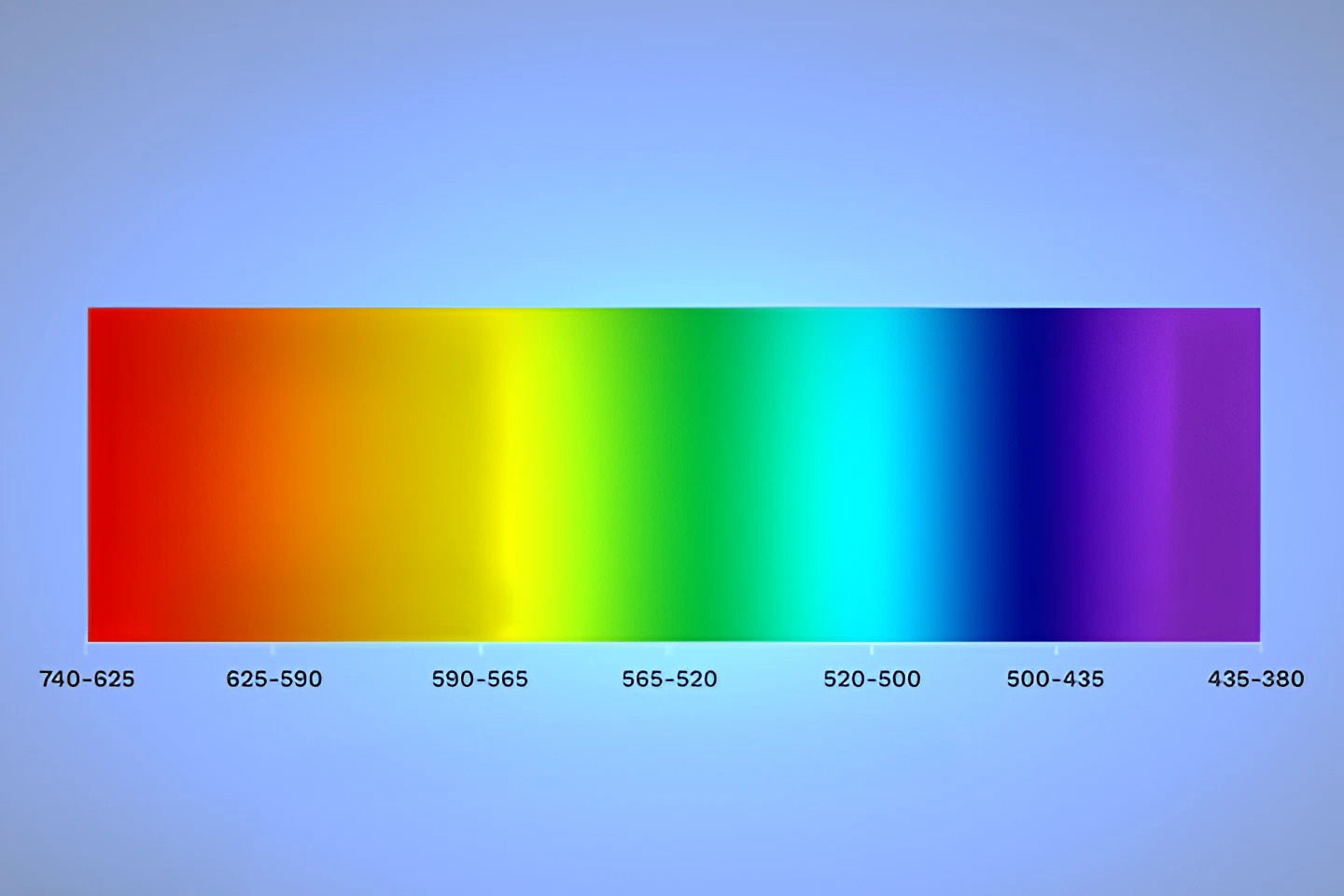Welcome to our blog! Our class is concerned with learning today's intriguing visible light and color spectrum. But what do visible light waves show us? We will go deeper in detail about how light reflects and absorbs from our eyes to create the colors we experience in the world.
What Do Visible Light Waves Show Us?
The nominal waves' lengths range from 400 to 700 nm (4,000-7,000 am), which is about 4-7×10^{-7} meters (40-70×10^{-10} meter). Our eyes understand the diversity of optical frequencies as diverse colors, from red to violet. Red light has a longer wavelength of about 700 nm and hence vibrates with lower frequency compared to blue light and carries less energy with about 430 terahertz, while each photon has about 1.8 electron volt (eV) of power. Inside those lines coincides, nevertheless, the blue and purple light of shorter waves rounding up at approximately 400 nm and vibrating at higher frequencies above 750 terahertz and 3.1 eV per photon.
Near the visible light on the electromagnetic LED light spectrum, you can find infrared radiation, which has more giant waves, lower frequency, and less energy than red light, and ultraviolet radiation, which has shorter wavelengths, higher frequency, and more energy than blue or violet light.
With a speed of 299,792 kilometers per second (equivalent to about 186,282 miles per second), light could orbit Earth seven times in a second! This fastness is the same for all electromagnetic waves irrespective of their type, usually symbolized by a capital "C" in equations like Einstein's "E = mc2". The light speed is the most in a vacuum and slightly slows down in materials such as water and glass. This is called refraction.
How Humans Perceive Light
Creating visual images involves the collaborative effort of the eye and brain. When we fixate on an object, our cornea, iris, and pupil allow light to pass through our lens to our eyes. The lens is refractive; hence, the light is bent in the middle, so the image becomes turned upside down and is projected on the retina at the end of the eye. This is a situation that excites or stimulates the rods and cones photoreceptors in the retinas. They are responsible for identifying color in the field of high illumination. In the dim lighting of the rod, monochromatic discrimination is known, and movement faster than that of general initiation is easily detected. The rods and cones work together to receive the light hitting the retina, which, during that mental process, is transformed into an electrical impulse that travels through the optic nerve from the eye to the brain. After that, the occipital, temporal, and parietal parts of the brain process the data and identify the form of the object that the eyes perceive.
Color Spectrum vs. Color Rendering Index
Color Rendering Index (CRI) is a metric through which the influence of light source on the appearance of an object's color to the human eye, including sharp color hue variations. This kind of measure shows how good it is at displaying accurate color representation. The values in the chromaticity index scale can be from 0 to 100%, where larger values indicate a higher color-rendering ability. Now, we can discuss what is a color spectrum.
While we consider the white light color spectrum, it's also necessary to be familiar with the concept of color temperature, which will apply to LED lights. The color temperature of the LED light defines the proportional amounts of white, yellow, red, and blue color as a given light. This is also the same as saying if the light is warm or cool under the white light. Kelvin units measure color temperature, which is the nature of the light, whether it is warm or cold, because it reflects some color part of the color spectrum.
The temperature is a subjective thing, the same as Kelvin: your perception and your choice. On average, the 3000K is used in residential areas, 4000K is efficient for offices and larger spaces, and 5000K is used in warehouses and outdoor spaces. Recently, the American Medical Association has warned against iodide radiation of more than 5000K, representing danger for human beings.
As the color rendering index is a comprehensive idea, it is mainly a color scheme. CRI statistics indicate the light source's color can reflect all the frequencies of its color spectrum when compared to an ideal reference light source. The color light spectrum we use is based on light wavelengths, which is probably a lot less important than it is for domestic or commercial lighting.
Unlike white light, the complete color spectrum is not necessarily critical in the selection process, but the CRI and Kelvin levels need to be considered.
LEDs are identified here as the best case of light advancement. They could have more lumen lighting and offer different temperature ranges, too. As for now, they have high RCI scores and are under constant technological development in order to expand their color gamut.
The Sun's Corona
The Sun is the primary source of visible light that our eyes perceive. The corona, the Sun's outermost atmospheric layer, is visible to the naked eye. However, due to its faintness, it can only be seen during a total solar eclipse when the bright photosphere is entirely obscured. A photograph taken during such an eclipse shows the photosphere and chromosphere nearly completely blocked by the moon. The Sun's corona forms tapered patterns, known as coronal streamers, created by an outward stream of plasma that follows magnetic field lines stretching millions of miles into space.
Negative Effects of Visible Light on Humans
- Vision
The ultraviolet light's high-level energy visible light and shorter wavelength compared to the rest are the other key characteristics that are dissipated and not so focused. This cannot be overemphasized with the use of screens like the ones on computers or laptops, which not only cause blue light to be dimmed but also affect the sharpness of the eyes. Over time, the person might sit in front of the screen so often that the problem can turn into one of digital eye fatigue, and to get rid of this, the person can have, in specific cases, a headache or neck and shoulder pains.
The main risk of prolonged blue light exposure is that people contract a higher rate of age-related macular degeneration as one possible outcome. Red light that reaches your eyes goes through the retina and targets the fovea only. In contrast, blue light penetrates deep enough into your eyes, reaching the macula responsible for your central vision. Other analysts are fictitious that besides, it might do harm to the small cells in your retina, which perceive light. In turn, it could result in the occurrence of macular degeneration, which is a primary source of vision impairment.
Physical blocks, as in glasses, represent an effective way for you to safeguard your eye from blue light-induced damage by suits with specially designed lenses.
- Skin
Contrary to UVA or UVB, which just reach beneath your skin, visible light penetrates deeper to damage the proteins like collagen and elastin, which hold the skin together. The consequence could be your skin shedding off its elasticity and stretching out, developing prominent wrinkles.
Applying sunscreen is suggested to protect your skin from the harmful effects of blue light. Sometimes, this sentence has a straightforward meaning but can also be intentionally ambiguous, leaving room for interpretation. Nevertheless, cost-efficiency is not the only aspect worth considering when choosing sunscreen. Rather than those with low SPF factors or little nourishing antioxidants, pick the ones with SPF 30+.





